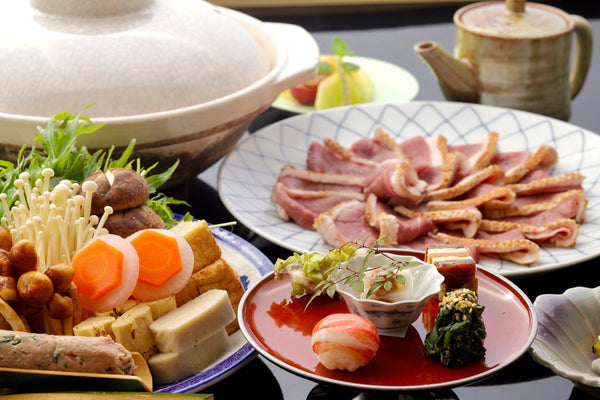
Jump to:
What is Nabe?
Nabe is a Japanese hotpot dish consisting of a soup, often served with a variety of ingredients, such as noodles, vegetables, and meat. This hearty dish is typically eaten during the winter and is cooked at the table in an earthenware pot. Nabe is usually cooked in a pot over an open flame, which helps gives the dish its distinctive smoky flavor. It can be made with any combination of meats and vegetables. It's also delicious served on rice, so it's perfect for lunch or dinner.
There are many different regional variations on nabe recipes across Japan, with each region boasting its own specialty dish. In this article we will explore some of the most popular variations across Japan and their different ingredients that you can try making at home.
How to Make Nabe – Essential Items and Ingredients
One of the best things about making nabe is that you can pretty much add any ingredients you like to the hotpot, however there are a few essential items that we recommend you use to create an authentic Japanese experience:
Donabe pot – nabe is usually cooked in a special dish called a donabe in Japanese. The dish is typically made from ceramic, which is particularly effective at retaining heat and good for cooking over an open flame or portable stove. These pots are available in cookware departments everywhere in Japan and come in different sizes and designs, from individual sized pots to larger pots for 12 people.
Portable gas stove for cooking – nabe can be cooked on a regular stove but if you want an authentic Japanese experience that you can share with family and friends, try cooking it on a portable gas stove (similar to a camping stove) on top of a communal dining table.
Soup base – although you can throw in any ingredients you like into the hotpot, a good soup base is important to making this dish authentic. You can either try making your own from soy sauce, miso, salt, or dashi broth or buy a ready-made soup base that you can just add straight to the dish (see below for recommendations).
To make nabe, prepare and cut your ingredients including meat, vegetables, and noodles onto a platter on the dining table. Place the nabe pot on the portable gas burner and pour the soup base into the dish. Once the broth is simmering, add your meat and vegetables and keep simmering until cooked – the vegetables usually cook more quickly than the meat so it’s probably best to add the meat first. Once cooked, ladle, and serve into soup bowls.
Best Nabe Soup to Buy
If you are looking to save time by buying a ready-made nabe soup you can just add straight to the pot, here are a few suggestions:
Ajinomoto Spicy Kimchi Nabe Cube – if you want to create a nabe dish that will keep you warm then this spicy kimchi soup will do the trick! Packaged in 8 convenient cubed servings, simply add the broth cube to your nabe pot with water and your nabe ingredients.
[callout-1]
Ajinomoto Soy Milk Nabe Cube – this soy milk base soup is perfect for adding extra umami flavor to nabe dishes to create a sweet and creamy broth. This soy milk hotpot, known as tonyu nabe in Japanese, is ideal with sliced pork loin, tofu, mushrooms, leafy greens, long green onion, carrot, and daikon radish.

Ajinomoto Rich White Flavour Nabe Cube - these nabe cubes have a pork and chicken bone flavor. The soup is rich in taste and is made from boiling pork and chicken bones until simmering, so it’s perfect for creating nabe variations like Mizutaki. The soup also includes flavors and fragrant aromas of ginger, garlic, vegetables, and bonito.
[callout-2]
Ajinomoto Dashi Stock Vegetables Nabe Cube – if you prefer a nabe soup that is made from vegetables rather than meat bones, then this is the soup for you. Made from ten different kinds of vegetables, these nabe soup cubes create a rich amber-colored tasty broth, suitable for any kind of nabe.

Mizkan Shiro Dashi Sauce Professional Taste – this light-colored dashi sauce from Mizkan can be diluted with water to create an instant nabe soup. Made with high quality ingredients such as chicken broth, Japanese bonito flakes, and kombu seaweed, the sauce brings a savory and salty umami flavor to any nabe hotpot and can also be used as a soup for noodle dishes.
[callout-3]
Variations of Nabe Dishes
There are many variations of the traditional nabe dish that you may have come across in Japan including:
Oden – a simmered dish that you’ll often see sold throughout Japanese convenience stores during the winter. You can make oden in a donabe pot or other deep pot that you have at home. Traditionally, oden is made using a dashi broth and its ingredients include fish cakes, deep-fried tofu, hard-boiled eggs, konnyaku, and vegetables.
Sukiyaki – a dish served with marbled beef and usually prepared in a cast iron pot. Thin slices of beef are simmered at the table along with ingredients such as tofu, long green onions, cabbage, and mushrooms, cooked together in a soy sauce broth. Traditionally in Japan the ingredients are then dipped in raw egg after cooking before being eaten, but if you are based outside Japan, it may be safer to skip this part!
Shabu Shabu – this dish is similar to sukiyaki, but the meat is cooked in a kombu seaweed-based broth instead of soy sauce. Once cooked, the meat is dipped in side sauces such as ponzu and sesame sauce. Shabu shabu can be cooked in a donabe pot, and common ingredients along with beef or pork include tofu, cabbage, long green onion, and carrot.
Five Different Kinds of Nabe You Can Try at Home!
Yosenabe refers to the basic Japanese hotpot where you can add whatever ingredients you like to a dashi-based broth. This dish is really convenient if you have a lot of vegetables or meat that needs using up before the expiration date, but you don’t really know what to do with them! Read on to discover five popular nabe variations you can try if you are looking for a specific recipe.
Chanko Nabe
This is a popular meal traditionally eaten by sumo wrestlers to help them to gain weight and is rich in protein. The soup is usually made with dashi stock, or a chicken broth, and common ingredients include chicken meat, fish, pork belly, tofu, cabbage, mushrooms, carrots, and long green onions.
If you ever visit Tokyo’s Ryogoku area, you can find chankonabe restaurants that have been set up by ex-wrestlers like Chanko Kawasaki, a traditional family-run restaurant with private tatami floor dining rooms and Hana No Mai, an izakaya that serves chanko nabe and stages live sumo shows!

Bishu Nabe
This simple nabe dish consists of chicken or pork boiled together with vegetables such as daikon radishes, shiitake mushrooms, cabbage, Japanese sake, salt, and pepper. It is thought to have originated in the town of Saijo, located in Hiroshima prefecture. Saijo is famous for its sake breweries and this hot pot is said to have been invented by the sake brewers to eat in the warehouse when they were hungry.

Ishikari Nabe
Ishikari nabe originally comes from Japan’s most northern prefecture of Hokkaido and makes use of their regional specialties such as fresh seafood, seasonal vegetables, and potatoes. The soup stock is usually made from kombu, a kind of seaweed, and miso, and instead of meat it usually contains salmon, potatoes, cabbage, corn, onion, and daikon radishes. As Hokkaido is famous for its dairy products, a generous serving of butter is usually added to the top of the hotpot and melted into the stew before serving.

Hakata Mizutaki Nabe
This variation of nabe comes from the Fukuoka region in Kyushu, and first became popular during the Meiji period (1868-1912). It is different from other types of nabe because the soup is made by bringing to a boil chicken and water at the same time, rather than adding chicken to an already boiling pot, creating a cloudy white colored soup broth. Once the chicken soup broth is ready, you can add boneless, skinless chicken thighs, chicken meatballs, tofu, and vegetables such as long green onion (negi), cabbage, and mushroom.

Curry Nabe
A less traditional variation of hotpot, curry nabe is becoming increasingly popular and you can even find it in Japanese supermarkets nowadays. For example, CoCo Ichibanya, a popular chain of curry restaurants, sell a ready-made cheese curry nabe soup you can make at home. If you are based outside of Japan, you can make your own curry nabe by adding two tablespoons of curry powder to your soup base along with tsuyu soup base sauce, water, and four tablespoons of starch. Once the sauce is ready, add ingredients such as pork thigh, thick fried tofu, carrots, cabbage, beansprouts, and mushrooms.






0 comments